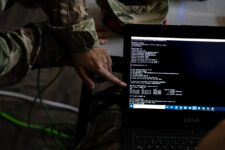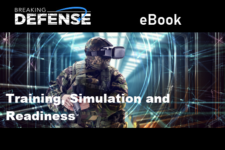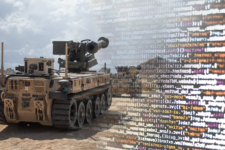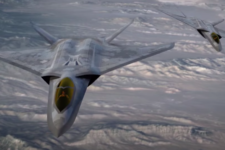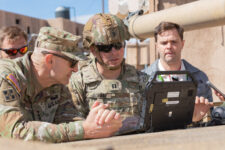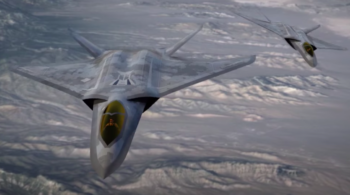
Nand Mulchandani
WASHINGTON: The Pentagon is building lots of awesome hardware, from aircraft carriers to robot tanks, from stealth bombers to laser weapons. But in fast-paced future fights, it’s software that will be decisive, says the acting director of the Joint Artificial Intelligence Center. Why? Because you can rewrite your code much faster than you can upgrade any physical weapon, Nand Mulchandani told me, letting you adapt to exploit the enemy’s weak points faster than he can adapt to exploit yours.
“The organization that’s going to be victorious in the future is going to be the organization [with] the maximum agility to bring out new capabilities and learn very, very quickly how to adapt,” Mulchandani said in an interview ahead of the Pentagon AI conference he’ll host this week. “The speed at which you are able to change your tactics, change your planning, and react to changes your adversary is making is fundamentally where the game is going in the future – and the only way to take advantage of that… is to be more software-centric rather than being hardware-centric.”

Coders from the Air Force’s Kessel Run in action
SoftWar
Putting software over hardware will be a cultural revolution for the military, just as it was a culture shock for Mulchandani to join the Pentagon last year after working for most of three decades in Silicon Valley, where he grew up. “I’ve been here now a year, and it’s taken me a year to truly understand the depths and scope of the operations of the Department of Defense,” he told me. “We in the Valley have just stopped touching hardware in any way shape or form. [In] the Department of Defense… we have tons and tons of hardware and people that are out there in the field.”
“That’s why it takes so long and it’s hard to actually make change happen, because you have to impact physical systems,” Mulchandani said. But “one of the biggest transformations” in Silicon Valley over the last two decades, he said, is the idea of virtualization. Sure, you still need physical assets, but you rely on software to control that hardware and operate it in the optimal way. In essence, you’re trying to turn your intractable hardware problems, which may take years to fix, into software programs your algorithms can solve in minutes.
Today, internet and cloud service providers use virtualization to automatically bring on new servers in seconds when user demand begins to spike, making the necessary configuration and organizational changes without any human intervention. The Pentagon can reap similar benefits, Mulchandani says, by digitally connecting its far-flung physical forces.
“Being able to coordinate and bring [together] a complete ensemble of different capabilities” – whether in business or on the battlefield – “is an incredibly hard computer science problem,” Mulchandani said. “If we’re successful, this will fundamentally change the nature of how we operate.”
Think of how Netflix went from mailing users physical DVDs – which took days – to transmitting streaming video on demand, Mulchandani said: “Do we have a Netflix DVD moment coming in warfare?
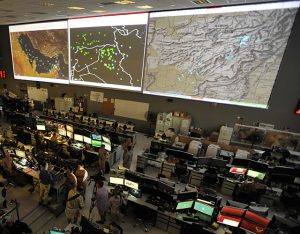
Combined Air Operations Center (CAOC), Al Udeid Air Base, Qatar
Speed Is Life, But Manual Means Slow
This kind of “software-defined warfare” doesn’t mean replacing grunts with robots, Mulchandani says. “We can’t digitize infantry, but we can digitize the information about the infantry,” he told. “Where are the munitions? How many do you have of them? Where are your people? What is their level of readiness? How many units have people out sick? Are they ready to be deployed?”
“These are highly, highly complex combinatorial questions that are currently in many cases hand-calculated,” he said. Staff officers spend countless hours manually updating Excel spreadsheets and passing sticky notes because different computer systems can’t share data electronically. By contrast, he told me, an investment firm like Goldman Sachs can spot an opportunity for profitable arbitrage and swiftly write specific software to exploit that window over and over before it closes.
The difference is between business and warfare is that in war, moving slowly is not just inefficient: It’s potentially deadly if you come up against an enemy who can react faster than you.

German mechanized forces advancing through Ukraine in 1942. Note the prominent radio aerials on several vehicles: Radio networks were essential to coordinate fast-moving operations.
In studies of jet fighter combat, Air Force Col. John Boyd found that pilots who swiftly grasped the situation and adapted to it could consistently shot down slower-thinking foes, even if the enemy planes were better. The same principle, he realized, applies to entire armies. Witness the blitzkrieg years of World War II, when Nazi Germany had fewer and smaller tanks than its adversaries did but used them better, its tacticians outmaneuvering large but slow-responding French and Soviet formations. So Boyd coined the influential concept of the OODA loop now widely used in military training: Observe the situation, Orient yourself to what matters, Decide what to do, and Act.
What Mulchandani is talking about, in essence, is speeding up the OODA loop by automating laborious staff work: sifting through intelligence data, cross-referencing different sensor feeds, updating unit status reports, mapping routes of advance, finding the weapon to strike a particular target, and on and on ad nauseam. “Targets, logistics, people, readiness, health, supplies, maintenance — all these variables, it’s beyond the ability of a single human being or set of human beings to optimize,” he said. “That’s why we invented computers.”

Multi-Domain Operations, or All Domain Operations, envisions a new collaboration across land, sea, air, space, and cyberspace (Army graphic)
Command & Control
The US military has a lot of data now, but very limited ability to share it. So the Pentagon in general, and the Joint AI Center in particular, are increasingly focused on what’s called Joint All-Domain Command & Control (JADC2): a meta-network that can seamlessly share intelligence, orders, and other data across forces operating in all five military “domains” – land, sea, air, space, and cyberspace.
“JADC2 allows you to start interconnecting and doing planning around very complex maneuvers [and then] execute those complex things in order,” Mulchandani said. In some cases, he said, the computer will be turning a commander’s scheme of maneuver into specific instructions for subordinates to carry out: fly this plane here, unload these supplies there. But in others, the instructions could go directly from one machine to another: telling a radar where to scan, a jammer what enemy frequencies to disrupt, a laser which drone to shoot down, or a malware package which network to hack.
But don’t mistake JADC2 for Skynet or some other fictional master computer bent on murder. First all of, Mulchandani said, it won’t be a single entity, but a meta-network that brings many lesser networks together – much like the Internet itself.
“The internet is not a single network, it’s a multitude of networks that are all peered together,” he said. “Similarly, JADC2 is not a single object or a single piece of software [or even] running on a single network.”

A simplified (yes, really) overview of the Army’s IBCS command-and-control network for air and missile defense.
The Defense Department has “thousands and thousands of sub-networks around the world,” Mulchandani said. They’re all optimized for different purposes, from running satellites in orbit, to managing a base in the US, to coordinating combat troops on the front line. You wouldn’t want to lose all these specialized systems and start over, even if you could afford to replace every existing network with one net to rule them all. You need to find ways to connect them and get them to communicate – which is hard enough with legacy systems that weren’t designed to work together.
“We’re not going to clean everything out and start from scratch,” Mulchandani said. “Stitching together these very complex systems into a common backplate is really the key.”
Second, no matter how complexly interconnected the machines become, the Pentagon insists that human beings will always be in charge. “The law is very clear, our policies are very clear,” Mulchandani said. “There are no autonomous weapons systems that we’re building.”
“[With] our commanders… our intel officers… there’s still a huge amount of manual oversight and intervention on the decision-making process [and] things like targeting,” he said. “That’s not going to go away and we’re not trying to automate that away.”
In fact, Defense Secretary Mark Esper recently released new guidelines for ethical use of military AI that builds up longstanding prohibitions against autonomous killing machines. “Al this ethics and policies work that we’re doing, we’re not trying to do theater here,” Mulchandani said. “The department truly cares about this in a visceral way.”
But, he warned, that’s not true of every nation working on military robotics and AI.
We fed every 2024 Pentagon briefing into ChatGPT. Here’s what it thought.
The US national security establishment is cautiously embracing generative AI, so Breaking Defense decided to do an experiment.

